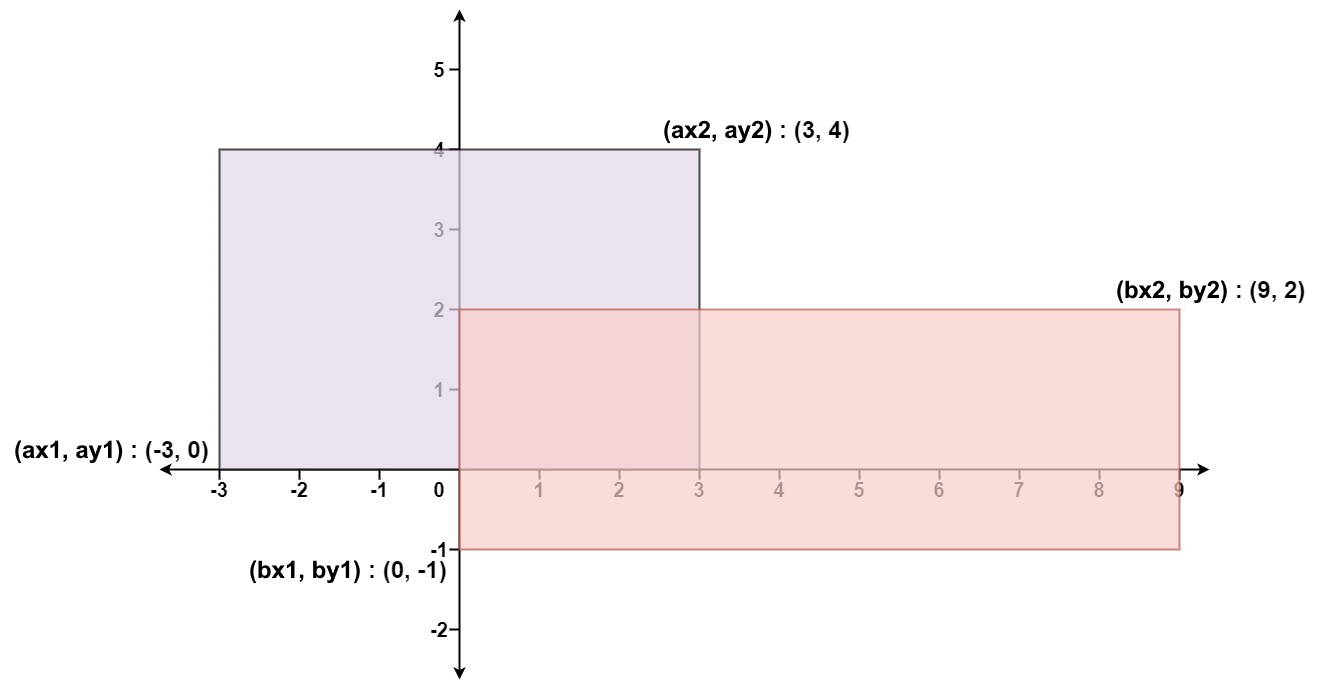Geometry
Math
Description
Given the coordinates of two rectilinear rectangles in a 2D plane, return the total area covered by the two rectangles .
The first rectangle is defined by its bottom-left corner (ax1, ay1) and its top-right corner (ax2, ay2).
The second rectangle is defined by its bottom-left corner (bx1, by1) and its top-right corner (bx2, by2).
Example 1:
Input: ax1 = -3, ay1 = 0, ax2 = 3, ay2 = 4, bx1 = 0, by1 = -1, bx2 = 9, by2 = 2
Output: 45
Example 2:
Input: ax1 = -2, ay1 = -2, ax2 = 2, ay2 = 2, bx1 = -2, by1 = -2, bx2 = 2, by2 = 2
Output: 16
Constraints:
-104 <= ax1 <= ax2 <= 104 -104 <= ay1 <= ay2 <= 104 -104 <= bx1 <= bx2 <= 104 -104 <= by1 <= by2 <= 104
Solutions
Solution 1: Calculate Overlapping Area
First, we calculate the area of the two rectangles separately, denoted as \(a\) and \(b\) . Then we calculate the overlapping width \(width\) and height \(height\) . The overlapping area is \(max(width, 0) \times max(height, 0)\) . Finally, we subtract the overlapping area from \(a\) and \(b\) .
The time complexity is \(O(1)\) , and the space complexity is \(O(1)\) .
Python3 Java C++ Go TypeScript C#
1
2
3
4
5
6
7
8
9
10
11
12
13
14
15
16
17 class Solution :
def computeArea (
self ,
ax1 : int ,
ay1 : int ,
ax2 : int ,
ay2 : int ,
bx1 : int ,
by1 : int ,
bx2 : int ,
by2 : int ,
) -> int :
a = ( ax2 - ax1 ) * ( ay2 - ay1 )
b = ( bx2 - bx1 ) * ( by2 - by1 )
width = min ( ax2 , bx2 ) - max ( ax1 , bx1 )
height = min ( ay2 , by2 ) - max ( ay1 , by1 )
return a + b - max ( height , 0 ) * max ( width , 0 )
class Solution {
public int computeArea ( int ax1 , int ay1 , int ax2 , int ay2 , int bx1 , int by1 , int bx2 , int by2 ) {
int a = ( ax2 - ax1 ) * ( ay2 - ay1 );
int b = ( bx2 - bx1 ) * ( by2 - by1 );
int width = Math . min ( ax2 , bx2 ) - Math . max ( ax1 , bx1 );
int height = Math . min ( ay2 , by2 ) - Math . max ( ay1 , by1 );
return a + b - Math . max ( height , 0 ) * Math . max ( width , 0 );
}
}
class Solution {
public :
int computeArea ( int ax1 , int ay1 , int ax2 , int ay2 , int bx1 , int by1 , int bx2 , int by2 ) {
int a = ( ax2 - ax1 ) * ( ay2 - ay1 );
int b = ( bx2 - bx1 ) * ( by2 - by1 );
int width = min ( ax2 , bx2 ) - max ( ax1 , bx1 );
int height = min ( ay2 , by2 ) - max ( ay1 , by1 );
return a + b - max ( height , 0 ) * max ( width , 0 );
}
};
func computeArea ( ax1 int , ay1 int , ax2 int , ay2 int , bx1 int , by1 int , bx2 int , by2 int ) int {
a := ( ax2 - ax1 ) * ( ay2 - ay1 )
b := ( bx2 - bx1 ) * ( by2 - by1 )
width := min ( ax2 , bx2 ) - max ( ax1 , bx1 )
height := min ( ay2 , by2 ) - max ( ay1 , by1 )
return a + b - max ( height , 0 ) * max ( width , 0 )
}
1
2
3
4
5
6
7
8
9
10
11
12
13
14
15
16 function computeArea (
ax1 : number ,
ay1 : number ,
ax2 : number ,
ay2 : number ,
bx1 : number ,
by1 : number ,
bx2 : number ,
by2 : number ,
) : number {
const a = ( ax2 - ax1 ) * ( ay2 - ay1 );
const b = ( bx2 - bx1 ) * ( by2 - by1 );
const width = Math . min ( ax2 , bx2 ) - Math . max ( ax1 , bx1 );
const height = Math . min ( ay2 , by2 ) - Math . max ( ay1 , by1 );
return a + b - Math . max ( width , 0 ) * Math . max ( height , 0 );
}
public class Solution {
public int ComputeArea ( int ax1 , int ay1 , int ax2 , int ay2 , int bx1 , int by1 , int bx2 , int by2 ) {
int a = ( ax2 - ax1 ) * ( ay2 - ay1 );
int b = ( bx2 - bx1 ) * ( by2 - by1 );
int width = Math . Min ( ax2 , bx2 ) - Math . Max ( ax1 , bx1 );
int height = Math . Min ( ay2 , by2 ) - Math . Max ( ay1 , by1 );
return a + b - Math . Max ( height , 0 ) * Math . Max ( width , 0 );
}
}
GitHub

